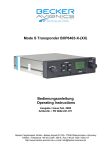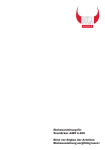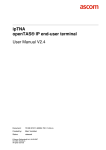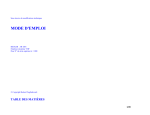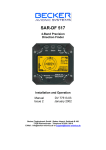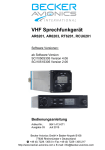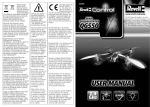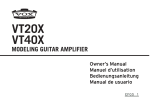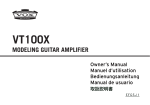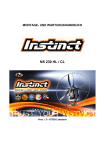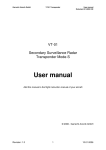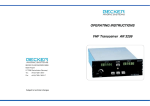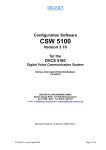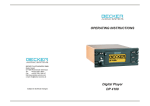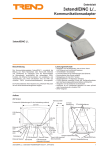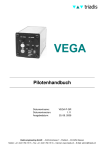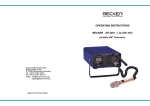Download Becker Transponder BXP6401
Transcript
Mode S Transponder Einblockgerät / Single Block Unit BXP 6401-X-(XX) und Bediengerät / and Control Unit CU 6401-1-(XX) Bedienungsanleitung Operating Instructions Ausgabe / Issue Januar/y 2006 Artikel-Nr. / PN 0591.823-071 Becker Flugfunkwerk GmbH • Baden-Airpark B 108 • 77836 Rheinmünster • Germany Telefon / Telephone +49 (0) 7229 / 305-0 • Fax +49 (0) 7229 / 305-217 http://www.becker-avionics.de • e-mail: [email protected] Bedienung/Operation XPDR Mode S Inhaltsverzeichnis / Table of Contents Seite / Page 1. Wichtig ............................................................................................................................................. 4 2. Einleitung ......................................................................................................................................... 4 2.1 Sicherheitshinweise .......................................................................................................................... 4 2.2 Liste der Abkürzungen ...................................................................................................................... 5 3. Bedienung ........................................................................................................................................ 6 3.1 Bedien- und Anzeigeelemente .......................................................................................................... 6 3.2 Bedienungsanleitung ........................................................................................................................ 8 4. Transponderbeschreibung .............................................................................................................. 17 4.1 Geräte-Zulassungen ....................................................................................................................... 17 5. Systembeschreibung ...................................................................................................................... 18 6. Technische Daten........................................................................................................................... 19 6.1 BXP 6401-X-(XX)............................................................................................................................ 19 6.2 CU 6401-1-(XX) .............................................................................................................................. 21 7. Reparaturhinweise .......................................................................................................................... 22 7.1 Gerätehandbücher.......................................................................................................................... 22 1. Important ........................................................................................................................................ 23 2. Introduction..................................................................................................................................... 23 2.1 Safety information........................................................................................................................... 23 2.2 List of abbreviations........................................................................................................................ 24 3. Operation ....................................................................................................................................... 25 3.1 Controls and indicators ................................................................................................................... 25 3.2 Operating instructions..................................................................................................................... 27 4. Transponder description ................................................................................................................. 35 4.1 Equipment approvals ...................................................................................................................... 35 5. System description ......................................................................................................................... 36 6. Technical data ................................................................................................................................ 37 6.1 BXP 6401-X-(XX)............................................................................................................................ 37 6.2 CU 6401-1-(XX) .............................................................................................................................. 39 7. Repair instructions .......................................................................................................................... 40 7.1 Equipment manuals........................................................................................................................ 40 © Copyright bei / by Becker Flugfunkwerk GmbH 77836 Rheinmünster / Germany Alle Rechte vorbehalten. All rights reserved. Technische Änderungen vorbehalten. Subject to technical changes. Seite/Page 2 von/of 42 Bedienung/Operation XPDR Mode S Abbildungen / IIlustrations Abbildung 1: Frontansicht BXP 6401-X-(XX) und CU 6401-1-(XX) ........................................................ 6 Abbildung 2: Einschalt-Anzeige............................................................................................................. 8 Abbildung 3: AI-Anzeige ....................................................................................................................... 9 Abbildung 4: FN-Anzeige ...................................................................................................................... 9 Abbildung 5: Flight-Level-Anzeige......................................................................................................... 9 Abbildung 6: Fehler-Anzeige und Warnungs-Anzeige.......................................................................... 10 Illustration 1: Front panel of BXP 6401-X-(XX) and CU 6401-1-(XX) .................................................... 25 Illustration 2: Start-up indication .......................................................................................................... 27 Illustration 3: AI indication ................................................................................................................... 28 Illustration 4: FN indication .................................................................................................................. 28 Illustration 5: Flight level indication ...................................................................................................... 28 Illustration 6: Error indication and warning indication............................................................................ 29 Seite/Page 3 von/of 42 Bedienung/Operation XPDR Mode S 1. Wichtig Lesen Sie diese Bedienungsanleitung aufmerksam durch, bevor Sie den Transponder BXP 6401-1-(XX) Class 1 bzw. den BXP 6401-2-(XX) Class 2 oder das Bediengerät CU 6401-1-(XX) in Betrieb nehmen. Bewahren Sie diese Bedienungsanleitung sorgfältig auf. Sie enthält wichtige Sicherheitsund Bedienungsanweisungen für den Transponder und für das Bediengerät. 2. Einleitung Vielen Dank für den Kauf des Becker Mode S Transponders oder des Bediengerätes. Der Transponder bzw. das Bediengerät kann im Instrumentenbrett oder in der Bedienkonsole von Luftfahrzeugen installiert werden und ist leicht zu bedienen. Zur vollen Nutzung der Möglichkeiten Ihres Transponders lesen Sie bitte diese Bedienungsanleitung vollständig durch, bevor Sie mit der Bedienung beginnen. Wenn Sie irgendwelche Fragen hinsichtlich der Bedienung des Gerätes haben, dann wenden Sie sich an den nächst gelegenen Becker-Werksvertreter oder an den Becker-Kundendienst. Die Hervorhebungen VORSICHT, ACHTUNG und ANMERKUNG haben folgende Bedeutung: VORSICHT Ungenaues Befolgen oder Nichtbefolgen von Anweisungen oder Verfahren kann zu Verletzungen oder tödlichen Unfällen führen. ACHTUNG Ungenaues Befolgen oder Nichtbefolgen von Anweisungen oder Verfahren kann zu Fehlfunktionen oder zur Beschädigung des Gerätes führen. ANMERKUNG Besonderheit, auf die aufmerksam gemacht werden soll. 2.1 Sicherheitshinweise ACHTUNG: • Der Einbau des Mode S Transponders und des Bediengerätes in ein Luftfahrzeug darf grundsätzlich nur durch eine autorisierte Installationsfirma (LTB) erfolgen. Dabei sind immer die landesspezifischen Vorschriften zu beachten. • Die Programmierung des Adress-Modules AM 6400-1 mit der ICAO 24-bit-Adresse des Luftfahrzeuges darf nur in der Installationsfirma (LTB) oder im Herstellerwerk durchgeführt werden. • Gerät nicht einschalten, bevor Motoren bzw. Triebwerke gestartet sind. Gerät ausschalten, bevor Motoren bzw. Triebwerke abgestellt werden. Seite/Page 4 von/of 42 Bedienung/Operation XPDR Mode S • Die Nutzung des Gerätes in Umgebungstemperaturen unter -20°C und über +70°C ist zu vermeiden. • Die Installationsfirma (LTB) hat sicherzustellen, dass mit dem Transponder das entsprechende Adressmodul AM 6400-1 installiert ist und dass das Adressmodul korrekt programmiert wurde. 2.2 Liste der Abkürzungen AA ADLP AI ALT ATC BIT CBIT CCS CS EASA ELS EHS FAA FL FN GICB GND ICAO IBIT ID IDT IFR Lfz LTB MTL ON PBIT PN R SBY SEL SI SPI SSR STO TN VFR XPDR Aircraft Address, 24-bit ICAO (Luftfahrzeugadresse, 24-bit ICAO) Avionics Data Link Processor (Luftfahrt-Datenübertragungs-Prozessor) Aircraft Identifier (Tail Number) Altitude or transponder ALT mode (Höhe oder Höhenübertragungsbetrieb) Air Traffic Control (Luftverkehr-Kontrolle) Built-In Test (Selbsttest) Continuous Built-In Test (kontinuierlicher Selbsttest) Company Call Sign (Fluggesellschafts-Rufzeichen) Call Sign (Rufzeichen) European Aviation Safety Agency Elementary Surveillance (Grundüberwachung) Enhanced Surveillance (erweiterte Überwachung) Federal Aviation Administration Flight Level (Flugebene) Flight Number (Flugnummer) Ground Initiated Comm-B (von der Bodenstation initiierte Übertragung) Ground (Boden) International Civil Aviation Organization Initiated Built-In Test (ausgelöster Selbsttest) Identifier (Kennzeichen) Ident (Identifikation) Instrument Flight Rules (Instrumentenflugregeln) Luftfahrzeug Luftfahrttechnischer Betrieb Minimum Triggering Level (Auslöseschwelle) Transponder ON mode (Transponder eingeschaltet) Power-on Built-In Test (Einschalt-Selbsttest) Part Number (Teilenummer) Reply (Antwort) Standby mode (Bereitschaftsbetrieb) Selection (Auswahl) Surveillance Identifier (Kennzeichen der Überwachungsanlage) Spezieller Impuls zur Identifikation des Lfz Secondary Surveillance Radar (Sekundär-Überwachungs-Radar) Store (speichern) Tail Number (Luftfahrzeug-Nummer) Visual Flight Rules (Sichtflugregeln) Kurzbezeichnung für Transponder Seite/Page 5 von/of 42 Bedienung/Operation XPDR Mode S 3. Bedienung 3.1 Bedien- und Anzeigeelemente Abbildung 1: Frontansicht BXP 6401-X-(XX) und CU 6401-1-(XX) Seite/Page 6 von/of 42 Bedienung/Operation XPDR Mode S Funktion der Bedien- und Anzeigelemente: Ref. zu Abb. 1 Bedien- und Anzeigelemente Beschreibung Funktion A Betriebsartenschalter Drehwahlschalter mit 4 Raststellungen Position OFF: Transponder ist ausgeschaltet Position SBY: Betriebsbereitschaft ist eingeschaltet Position ON: Betriebsart A/S ist eingeschaltet. Die Übertragung der Höhen-Information wird unterdrückt Position ALT: Betriebsart A/C/S ist eingeschaltet und die HöhenInformation wird übertragen B Drehschalter Optischer Dreh-Impulsgeber Drehschalter zur Änderung der (Drehfunktion von C) Einstellungen (16-stufig) C Taster Drucktaste (Druckfunktion von B) Tastendruck bewirkt den Sprung von Digit zu Digit (zwecks Einstellungen) oder von einem Menü zum nächsten; allgemein verwendet als Eingabetaste D IDT Drucktaster Aktiviert den Identifizierungsimpuls (SPI) für ca. 18 Sekunden zusätzlich zum Antwort-Code ; während dieser Zeit wird „ID“ im LC-Display angezeigt E Display, Teil 1 2-zeilige LC-Anzeige Anzeige der folgenden Informationen: - Code-Anzeige in der oberen Reihe - Flight-Level in der unteren Reihe - versch. Infos in der unteren Reihe - zusätzliche Anzeigen linksseitig (siehe auch Ref. H) F STO Drucktaster Speichert die eingestellten und geänderten Werte G SEL Drucktaster Öffnet das Menü H Display, Teil 2 LC-Anzeige Anzeige von zusätzlichen Indikatoren, (R für Reply, ID für Ident, ALT für XPDR Betriebsart ALT oder ON für XPDR Betriebsart ON, FL für Flight-Level) J VFR Drucktaster Aktiviert den vorgewählten VFR-Code in der unteren Display-Zeile Seite/Page 7 von/of 42 Bedienung/Operation XPDR Mode S 3.2 Bedienungsanleitung A. Einschalten des Gerätes (Vorflugkontrolle) (1) Bordnetz einschalten (kontrollieren, ob der Schutzschalter (circuit breaker) eingeschaltet ist. ACHTUNG: Gerät nicht einschalten, bevor Motoren bzw. Triebwerke gestartet sind. Gerät ausschalten, bevor Motoren bzw. Triebwerke abgestellt werden. (2) B. Transponder mit dem Betriebsartenschalter (A) von OFF auf SBY schalten, dabei folgt automatisch für 2 Sekunden ein Einschalttest (PBIT) des Gerätes. Siehe auch Abschnitt B für die Inbetriebnahme. Inbetriebnahme Mit dem Einschalten wird das Gerät in Betrieb genommen. Die Software initialisiert das Gerät und führt den Einschalttest (PBIT) aus. Während dieser Zeit sieht die Display-Anzeige wie folgt aus:. Abbildung 2: Einschalt-Anzeige Wenn nach Ablauf des Einschalttestes keine Fehlermeldung im Display erscheint, dann schaltet der Transponder in den vom Betriebsartenschalter (A) bestimmten Mode. C. CODE-Anzeige Der Transponder-Code wird in den Betriebsarten SBY, ON und ALT in der oberen Display-Zeile angezeigt. D. Luftfahrzeugidentifikation / Flugnummer Abhängig von den Konfigurationseinstellungen wird das Lfz-Kennzeichen (AI) oder die Flugnummer (FN) in der unteren Display-Zeile wie folgt angezeigt: Seite/Page 8 von/of 42 Bedienung/Operation XPDR Mode S Abbildung 3: AI-Anzeige Abbildung 4: FN-Anzeige E. Flugebene (Flight-Level) Der Flight-Level wird in der Betriebsart ALT in der unteren Display-Zeile angezeigt (Höhe = FL x 100 in ft): Abbildung 5: Flight-Level-Anzeige F. Selbsttests des Gerätes (BITs) Die folgenden, verschiedenen Tests sind im Transponder integriert oder können am Transponder ausgelöst werden: (1) Der IBIT (Initiated Built-In Test) kann mit dem gleichzeitigen Drücken der Tasten (F) und (G) in jeder Betriebsart aktiviert werden (ausgenommen im KonfigurationMode). Der Test startet mit dem Drücken der zweiten Taste. Der IBIT funktioniert wie folgt in allen Betriebsarten: Der Test startet mit allen verfügbaren Testroutinen einschließlich der Sendertestroutine. Während des Tests wird “IBIT” im Display angezeigt. Der Testablauf dauert nicht länger als 1 Sekunde. Wenn der IBIT erfolgreich war, schaltet der Transponder sofort zurück in die angewählte Betriebsart. Während dem IBIT werden keine anderen Schalterbetätigungen anerkannt. Seite/Page 9 von/of 42 Bedienung/Operation XPDR Mode S Negative IBIT-Ergebnisse werden im Display mit “FAILURE” angezeigt. Der Transponder kann nicht in die Betriebsarten ON oder ALT geschaltet werden, wenn irgendein Fehler gefunden wurde. (2) Der CBIT (Continuous Built-In Test) arbeitet wie folgt: Der CBIT bewirkt eine Überwachung während des Transponder-Betriebes. Negative CBIT-Ergebnisse werden im Display mit “FAILURE” angezeigt. Der Transponder kann nicht in die Betriebsarten ON oder ALT geschaltet werden, wenn irgendein Fehler gefunden wurde. (3) Der PBIT (Power-on Built-In Test) funktioniert wie folgt: Der Tranponder hat einen Einschalt-Selbsttest (PBIT). Während dem PBIT werden keinen anderen Schalterbetätigungen anerkannt. Während dem PBIT befindet sich der Transponder in der Betriebsart Standby (SBY), dies wird aber nicht im Display angezeigt. Die Anzeige der Betriebsart im Display erfolgt sofort nach Beendigung des PBIT. Negative Ergebnisse werden im Display mit “FAILURE” angezeigt. Der Transponder kann nicht in die Betriebsarten ON oder ALT geschaltet werden, wenn irgendein Fehler gefunden wurde. Der PBIT dauert nicht länger als 1 Sekunde. Wenn der Test erfolgreich war, schaltet der Transponder sofort in die angewählte Betriebsart. Abbildung 6: Fehler-Anzeige und Warnungs-Anzeige Seite/Page 10 von/of 42 Bedienung/Operation XPDR Mode S G. Auswahlmodus Um in den Auswahlmodus zu gelangen, die SEL-Taste drücken (G) und den Schalter (B) drehen. Im Auswahlmodus werden zusätzliche Informationen in der unteren Display-Zeile angezeigt. Einige der Daten sind veränderbar, andere sind nur lesbar: G.1 VFR 4096 Code - Einstellung veränderbar; siehe Abschnitt G.2 AI Lfz-Kennzeichen (Lfz-Nummer) fest; lesbar nur aus dem Adressmodul (kann ersetzt werden durch FN) Wenn kein gültiger AI gespeichert ist, wird “- - - - - - - -“ angezeigt. FN Flugnummer oder Flug- veränderbar; siehe Abschnitt G.1, gesellschafts-Rufzeichen kann ersetzt werden durch AI (fest) mit Auswahl “AI DEF” AA Lfz-Adresse (24-bit ICAO) fest; lesbar nur aus dem Adressmodul (einmalig vergebene Nr. für jedes Luftfahrzeug) MA max. Geschwindigkeit fest; lesbar nur aus dem Adressmodul AT Lfz-Typ fest; lesbar nur aus dem Adressmodul CFG Konfiguration nur im SBY-Betrieb verfügbar; siehe Abschnitt L INS nur im SBY-Betrieb verfügbar; gesichert durch Passwort Installationseinstellung Lfz-Identifikation (AI oder FN) mit Flugplan: Definition aus dem Flugplan: z.B. Flugnummer oder Fluggesellschafts-Rufzeichen ohne Flugplan (VFR): Lfz-Kennzeichen (Rufzeichen) Die AI-Anzeige in der unteren Display-Zeile ist nur im Konfigurations-Menü in den Betriebsarten SBY und ON anwählbar. Das Lfz-Kennzeichen (fest) ist in jeder Betriebsart nach Drücken der SEL-Taste (G) und dem Drehen des Schalters (B) sichtbar. Der Standardwert für den AI ist das Lfz-Kennzeichen, er ist im Adressmodul gespeichert. Wenn ein Flugplan existiert, so ist zu prüfen, welches AI-Kennzeichen verwendet werden soll. Wenn eine Flugnummer zugeteilt wurde, so muss diese benutzt werden. Wird ein Fluggesellschafts-Rufzeichen zugeordnet, so ist dies zu verwenden. Zu sehen ist dies in der unteren Display-Zeile. Das AI wird im EEPROM vom Bedienkopf gespeichert. In diesem Fall ändert sich die Anzeige von AI zu FN (Flugnummer). Wenn das Lfz-Kennzeichen zugeteilt wird, ändert sich nichts, da dies die Standard-Einstellung vom Adressmodul ist. Seite/Page 11 von/of 42 Bedienung/Operation XPDR Mode S Einstellung der Flugnummer: (1) Taste SEL (G) drücken, um in den Auswahlmodus zu gelangen. (2) Schalter (B) drehen bis der AI angezeigt wird. (3) Taste (C) drücken, um zur FN umzuschalten. Der Cursor steht auf dem ersten Zeichen. (4) Schalter (B) drehen, um das Zeichen zu ändern. (5) Taste (C) drücken, um mit dem Cursor das nächste Zeichen anzuwählen. (6) Schritte 4 und 5 wiederholen, bis die Flugnummer eingestellt ist. (7) Wenn die Flugnummer aus weniger als 7 Zeichen besteht, so ist das Ende der Nummer anzuwählen und die restlichen Stellen mit Leerzeichen aufzufüllen. (8) Änderungen mit der Taste STO (F) abspeichern. Zum Verlassen der Einstellungsprozedur ohne Abspeicherung die Taste SEL (G) drücken. ANMERKUNG: Das Lfz-Kennzeichen bzw. die Flugnummer besteht aus max. 7 Zeichen (linksbündig). Striche oder Leerstellen sollen in der Nummer nicht eingeschlossen sein. Wenn die Flugnummer aus weniger als 7 Zeichen besteht, so sind die übrig gebliebenen Stellen an der rechten Seite mit Leerzeichen aufzufüllen. Zurückschalten zum Standard-AI: (1) Taste SEL (G) drücken, um in den Auswahlmodus zu gelangen. (2) Schalter (B) drehen bis zur Anzeige FN=XXXXXXXX. (3) Taste (C) einmal drücken zur Anzeige von ”FN=AI DEF” (invertiert). (4) Die Einstellung AI=DEF kann mit der Taste STO (F) gespeichert werden. Änderung der Flugnummer: (1) Taste SEL (G) drücken. (2) Schalter (B) drehen, bis FN angezeigt wird. (3) Taste (C) zweimal drücken, um in den FN Änderungsmodus zu gelangen. (4) Änderung der FN wie oben beschrieben durchführen. Seite/Page 12 von/of 42 Bedienung/Operation XPDR Mode S G.2 Voreinstellung des VFR-Codes Taste SEL (G) drücken, um in den Konfigurationsmodus zu gelangen (Auswahl wird im Display in der linken, unteren Ecke unter der Betriebsart angezeigt). (1) Schalter (B) drehen bis zur Display-Anzeige VFR=XXXX. (2) Taste (C) einmal drücken ⇒ linkes Digit vom Code ist invertiert. (3) Nun kann das Digit mit Schalter (B) geändert werden. (4) Taste (C) wieder drücken ⇒ nächstes linkes Digit vom Code ist invertiert. (5) Das nächste Digit kann mit Schalter (B) geändert werden. (6) usw. für die nächsten Digits. (7) Fünfter Druck auf Taste (C) ⇒ das erste Digit ist wieder invertiert. (8) Änderungen können jederzeit mit der Taste STO (F) gespeichert werden, in diesem Fall wird die Invertierung gestoppt. (9) Ein VFR-Code, der auf diesem Wege voreingestellt wurde, kann wie in Abschnitt I. beschrieben, aktiviert werden. (10) Für die Inversion ist eine Auszeit von 10 Sekunden vorgegeben, wenn keine Aktion ausgeführt wird. Es wird nichts abgespeichert, solange die Taste STO (F) nicht gedrückt wird. ANMERKUNG: Es ist möglich, das Einstellungsverfahren mit dem Druck auf die Taste SEL (G) jederzeit zu verlassen, dann ist der angewählte Modus verfügbar. Die Anzeige SEL im Display geht zurück auf die Anzeige der Betriebsart. Wenn die Taste STO (F) nicht betätigt wurde, dann wird auch keine vorgenommene Änderung gespeichert. H. Flugbetrieb im Modus A/C/S (Antwortcode und Höhencode) (1) Wenn von ATC die Aufforderung kommt, einen Code zu senden, z.B. „squawk“, dann ist der Transponder mit dem Betriebsartenschalter (A) in Stellung ALT zu schalten. ANMERKUNGEN: • Dies macht aber nur Sinn, wenn an den Transponder ein codierter Höhenmesser angeschlossen ist. Wenn nicht, so ist der ATC mitzuteilen, dass der Modus C nicht verfügbar ist („mode charlie not available“). Seite/Page 13 von/of 42 Bedienung/Operation XPDR Mode S • (2) In Ausnahmefällen ist die Höhenübertragung auszuschalten, d.h. der Transponder ist mit dem Betriebsartenschalter (A) auf ON zu schalten. Der Transponder antwortet mit dem eingestellten Code und übermiittelt der ATC auf Modus C-Abfragen die Flughöhe des Lfz. Ein „R“ im Display links neben dem Code signalisiert eine Transponderantwort (Reply). ANMERKUNG: Wenn der Code geändert werden soll, dann ist der Transponder in die Betriebsart Standby (SBY) zu schalten. Ansonsten könnte möglicherweise ein Code mit einer speziellen Bedeutung ausgesendet werden (siehe Abschnitt K, z.B. Entführung eines Lfz), was unerwünschte Folgen haben würde. (3) Nach Aufforderung durch ATC “squawk ident” ist die Ident-Taste (D) kurzzeitig zu drücken. Damit wird für ca. 18 Sekunden ein zusätzlicher ,spezieller Impuls (SPI) gesendet, der eine eindeutige Identifizierung des Lfz auf dem Radarschirm der ATC ermöglicht. Während dieser Zeit erscheint im Display linksseitig die Anzeige „ID“. (4) In einem normalen Einbau wird der Blind-Encoder mit Betriebsspannung versorgt, wenn der Transponder sich in einer der drei Betriebsarten SBY, ON oder ALT befindet. Ein Blind-Encoder benötigt möglicherweise eine Aufwärmzeit (bis zu einigen Minuten). Deshalb den Transponder sofort nach dem Starten der Motoren oder Triebwerke in Stellung SBY schalten, obwohl ein mit Halbleitern bestückter Transponder selbst keine Aufwärmzeit benötigt. I. Aktivierung des VFR-Codes (1) Taste VFR (J) drücken. Der voreingestellte Code wird angezeigt. Nach 3 Sekunden wird der angezeigte VFR-Code aktiv und überschreibt den früher eingestellten Code. (2) Durch erneutes Drücken der zuvor betätigten Taste (J) innerhalb von 3 Sekunden wird der früher eingestellte Antwortcode wieder aktiv. ANMERKUNG: Bei Auslieferung des Gerätes ist die VFR-Taste noch nicht mit einem Code belegt. Deshalb erscheint bei Betätigung dieser Taste für 0,5 Sekunden “----” in der CodeAnzeige, anschließend schaltet der Transponder auf den zuvor aktiven Code zurück. Seite/Page 14 von/of 42 Bedienung/Operation XPDR Mode S J. Internes und externes Ident Der spezielle Identifizierungssimpuls (SPI) kann durch Drücken der Taste IDT (D) am Bedienkopf oder über den entsprechenden externen Eingang des Transponders ausgelöst werden. Wenn der spezielle Identifizierungsimpuls ausgelöst wurde, dann erscheint die Anzeige “ID” im Display, solange der SPI aktiv ist. K. Spezielle Codierungen für Luftnotfälle (1) (2) Für bestimmte Luftnotfälle wurden spezielle Codierungen festgelegt, die in Zusammenhang mit der Art des Notfalles bestehen: • 7500 Entführung eines Luftfahrzeuges • 7600 Ausfall von Funkverbindungen • 7700 Notfall an Bord, der eine unmittelbare Gefahr für das Luftfahrzeug darstellt. Die Code-Auswerteeinrichtungen der Radaranlagen alarmieren automatisch die Controller an den Radarschirmen, sobald einer dieser speziellen Codes empfangen wird. Seite/Page 15 von/of 42 Bedienung/Operation XPDR Mode S L. Konfigurations-Modus Der Konfigurations-Modus ist nur im Standby-Betrieb verfügbar. Um in den Konfigurations-Modus zu gelangen, ist die Taste SEL (G) zu drücken und der Schalter (B) zu drehen, bis „CFG“ in der unteren Zeile des Display erscheint. Verfügbare Optionen sind in der folgenden Tabelle definiert. Auswahl mit Taste (C) Auswahl mit Drehschalter (B) 0% BRIGHTNESS (nur wenn der Dimmer-Eingang … im Installationsmenü auf „none“ 50 % … eingestellt ist) 100% Merkmale ILLUM CURVE (nur wenn externe Beleuchtungskontrolle im Installationsmenü eingestellt ist) VIEW CONFIG DEVICE INFO Speichertaste (F) Standard speichern speichern speichern speichern speichern speichern der Änderung AI IN SBY Standard ON OFF AI IN ON Standard ON OFF FL IN ALT Standard ON OFF nur Ansicht CU VER CORE VER FPGA VER DEV TYPE SERIAL NB nicht unterstützt ANMERKUNG: Wenn eine Art nicht verfügbar ist, gibt es keine Anzeige in diesem Feld. Seite/Page 16 von/of 42 Bedienung/Operation XPDR Mode S 4. Transponderbeschreibung Der Mode S Transponder und das Bediengerät sind bordseitige Bestandteile der Flugsicherungskontrolle (Air Traffic Control). Sie arbeiten nach dem Sekundär-RadarPrinzip und ermöglichen der ATC die Ortung, Identifizierung und Flugverfolgung von Luftfahrzeugen. Der Mode S Transponder besitzt folgende Merkmale: • Im selektiven Modus (Mode S) kann die Bodenkontrolle den Transponder individuell über eine spezielle ICAO-24-bit Adresse abfragen, welche eindeutig für das entsprechende Luftfahrzeug vergeben wurde. • Unterstützung des SI-Codes • Verfügbare Register für die Grundüberwachung (ELS) und die erweiterte Überwachung (EHS) • Extented Squitter-Übertragung • Fähigkeit, zusätzliche Daten zu übertragen Inhärente Funktionen: • Mode A - Betrieb , wobei der am Transponder eingestellte 4096-Code als Antwort auf die Abfrage einer Bodenstation zurückgesendet wird. • Mode C - Betrieb, wobei zusätzlich zu den Möglichkeiten von Mode A noch die verschlüsselte Flughöhe übertragen wird. Die Flughöhe wird durch den entsprechenden Flight-Level (Höhe in 100 ft-Schritten) im Display angezeigt. Der Höhencode wird dem Transponder von einem codierten Höhenmesser oder BlindEncoder zugeführt. • Ein spezieller Identifizierungsimpuls (SPI) kann durch Drücken der IDT-Taste im A/C-Betrieb und im Mode S aktiviert werden. • Selbsttests (BITs). Im Transponder integriert sind ein automatischer Einschalttest (PBIT), ein am Frontpanel auslösbarer Selbsttest (IBIT) und ein kontinuierlicher Test (CBIT) während des Betriebes. 4.1 Geräte-Zulassungen EASA.210.322 * FAA ETSO-2C112a TSO-C112 * anstehend Seite/Page 17 von/of 42 Bedienung/Operation XPDR Mode S 5. A. Systembeschreibung Mode A/C SSR SSR Mode A/C nutzen den im Luftfahrzeug eingebauten Transponder, um auf Abfragen der Bodenstation mit einem 4096-Code (Mode A) zu antworten und die Höheninformation (Mode C) in 100 ft. -Schritten zu übertragen. In Mode A wird der, von der ATC angeforderte Code von der Lfz-Besatzung im Cockpit über das Frontpanel des Transponders eingegeben. Die Position des Luftfahrzeuges in Bezug auf die Bodenstation wird von den, bei XPDRAntworten gemachten Bereichs- und Azimut-Messungen bestimmt. B. Mode S SSR Mode S ist eine Erweiterung des gegenwärtigen SSR, das die selektive Adressierung von einzelnen Luftfahrzeugen erlaubt. Außerdem können zusätzliche Daten vom Luftfahrzeug zum Boden übertragen werden. Jedem, mit einem Mode S Transponder ausgerüsteten Luftfahrzeug wird eine eindeutige 24-bit ICAO Lfz-Adresse zugeteilt. Mit Nutzung der selektiven Abfragefähigkeit sind SSR Mode S-Sensoren in der Lage, ein Luftfahrzeug über seine eindeutige 24-Bit Lfz-Adresse zuerst zu bestimmen und dann selektiv abzufragen. Dies verbessert die Fähigkeit der ATC, ein Lfz in der Luft als auch am Boden zu überwachen, bedeutend. Der Fortschritt von Mode S liegt in der Verwendung der selektiven Adressierung von Luftfahrzeugen, was technische Vorteile gegenüber dem konventionellen Sekundär-Radar bietet, so z. B. reduzierte FRUIT und Interferenzen. Der Mode S Transponder unterstützt den Überwachungs-Kennzeichen-Code (SI) mit temporärer, selektiver Aussperrung von bestimmten Abfragen auf Anweisung. Weiterhin unterstützt der Mode S Transponder den Flug-Status (Luft oder am Boden) und die Flughöhe in 25 ft.- Schritten, abhängig vom Raster der Datenquelle. C. Squitter Dieser Mode S Transponder ist in der Lage, erfasste Squitter und erweiterte Squitter zu übertragen. Squitter ist die Aussendung eines vorgegebenen Transponder-Formates, ohne die Notwendigkeit einer Abfrage. D. Höhenmessausrüstung Es ist erforderlich, dass der Höhenmesser einen Kodierer für die Höhenauswertung beinhaltet. In den meisten Fällen wird deshalb entweder ein Luftdatencomputer oder ein kodierter Höhenmesser eingesetzt werden. Seite/Page 18 von/of 42 Bedienung/Operation XPDR Mode S 6. Technische Daten 6.1 BXP 6401-X-(XX) Versorgungsspannung 10.0 V bis 33.0 V DC typische Stromaufnahme bei 50 Mode S Antworten / sec. + Squitter: 0,37 A bei 14 V (Beleuchtung aus) 0,22 A bei 28 V (Beleuchtung aus) 0,43 A bei 14 V (Beleuchtung max.) 0,25 A bei 28 V (Beleuchtung max.) im Standby-Betrieb: 0,22 A bei 14 V (Beleuchtung aus) 0,14 A bei 28 V (Beleuchtung aus) 0,28 A bei 14 V (Beleuchtung max.) 0,16 A bei 28 V (Beleuchtung max.) Panelbeleuchtung Dimmer-Eingang Beleuchtungsstromaufnahme max. 1 mA bei 28V Beleuchtungsfarbe (Display + Tasten) weiß Serielle Schnittstelle RS 422 Datenübertragungsfähigkeit 255 GICB Register Einschaltzeit 2 sec. (einschließlich interner Selbsttest) Interne Absicherung F5A Externe Absicherung 5 A (Class 1) 3 A (Class 2) Betriebstemperaturbereich - 20° C bis + 55° C (kurzzeitig + 70° C) Lagertemperaturbereich - 55° C bis+ 85° C Betriebshöhe 50000 ft. max. (Class 1) 15000 ft. max. (Class 2) Betriebsarten Mode A/C/S, abhängig von der Abfrage Mode S Class 1 oder 2, Level 2es - erweiterte Squitter - Fähigkeit - Überwachungskennzeichen (SI-Code) Seite/Page 19 von/of 42 Bedienung/Operation XPDR Mode S Empfangsfrequenz 1030 MHz ± 0,1 MHz (Mode A/C) 1030 MHz ± 0,01 MHz (Mode S) Empfindlichkeit (MTL) - 74 dBm ± 3 dB (für 90 % Antwortrate in Mode A/C und 99 % in Mode S) Sendefrequenz 1090 MHz ± 1 MHz Sendeleistung (Class 1) ≥ 125 W (+ 21 dBW) am Antennenfußpunkt und ≥ 250 W am Geräteausgang Sendeleistung (Class 2) ≥ 70 W (+ 18.5 dBW) am Antennenfußpunkt und ≥ 140 W am Geräteausgang Antwortcode (Mode A) ICAO Codierungssystem mit 4096 Antwortmöglichkeiten (Oktalcode) Höhencode (Mode C) ICAO Codierungssystem 100 ft. - Schritte von -1000 bis 62700 ft. Höhencode (Mode S) 25 ft. oder 100 ft. - Schritte (abhängig von der Quelle) Mechanische Abmesssungen: - Frontplatte 61,3 x 61,3 mm (H x B) (2.413 x 2.413 inch) - Instrumentendurchmesser 58 mm (2¼ inch) - Gehäusetiefe ohne Antennenbuchse mit Antennenbuchse mit Adressmodul Gewicht 192 mm (7.599 inch) 206 mm (8.110 inch) 239 mm (9.409 inch) ca. 0,8 kg Seite/Page 20 von/of 42 Bedienung/Operation XPDR Mode S 6.2 CU 6401-1-(XX) Versorgungsspannung 10,0 bis 33,0 V DC typische Stromaufnahme 0,045 A bei 14 V (Beleuchtung aus) 0,034 A bei 28 V (Beleuchtung aus) 0,138 A bei 14 V (Beleuchtung max.) 0,080 A bei 28 V (Beleuchtung max.) Panelbeleuchtung Dimmer-Eingang Beleuchtungsstromaufnahme max. 1 mA bei 28 V Beleuchtungsfarbe (Display + Tasten) weiß Steuerungs-Schnittstelle RS 422 Einschaltzeit 2 sec. (einschließlich internem Selbsttest) Interne Absicherung F1A Externe Absicherung 1A Betriebshöhe 50000 ft. max. Betriebstemperaturbereich - 20° C bis + 55° C (kurzzeitig + 70° C) Lagertemperaturbereich - 55° C bis + 85° C Mechanische Abmessungen: - Frontplatte 61,3 x 61,3 mm (H x B) (2.413 x 2.413 inch) - Instrumentendurchmesser 58 mm (2¼ inch) - Gehäusetiefe 65 mm (2.559 inch) Gewicht 0,22 kg Seite/Page 21 von/of 42 Bedienung/Operation XPDR Mode S 7. Reparaturhinweise Sollte ein Gerätefehler auftreten, so wenden Sie sich bitte an den nächst gelegenen BeckerWerksvertreter, Händler oder an den Becker-Zentralkundendienst. Die ausgefüllte Fehlerbeschreibung verkürzt die Reparaturzeiten und senkt somit die entstehenden Kosten. Diese Bedienungsanleitung ersetzt nicht die nachstehend aufgeführten Gerätehandbücher (Manuals). 7.1 Gerätehandbücher zu beziehen vom Hersteller oder vom Becker-Werksvertreter: BXP 6401-X-(XX) Installation and Operation BXP 6401-X-(XX) Maintenance and Repair CU 6401-1-(XX) Installation and Operation CU 6401-1-(XX) Maintenance and Repair BXP 6402-XR-(XX) Installation and Operation BXP 6402-XR-(XX) Maintenance and Repair Control Interface Protocol BXP 6402-XR-(XX) Data Transfer Interface Protocol BXP 640X-XX-(XX) Seite/Page 22 von/of 42 Artikel-Nr. 0584.053-071 Artikel-Nr. 0584.061-071 Artikel-Nr. 0584.096-071 Artikel-Nr. 0584.101-071 Artikel-Nr. 0584.071-071 Artikel-Nr. 0584.088-071 Artikel-Nr. 0590.241-071 Artikel-Nr. 0590.258-071 Bedienung/Operation XPDR Mode S 1. Important Please read these operating instructions carefully before operating the single block transponders BXP 6401-1-(XX) class 1, BXP 6401-2-(XX) class 2 and the control unit CU 6401-1-(XX). Keep these operating instructions carefully. They contain important safety and operating instructions for the Mode S transponder and the control unit . 2. Introduction Thank you for purchasing the Becker ATC Mode S transponder or control unit. The transponder and the control unit respectively can be installed in the instrument panel and is easy to operate. To fully utilise the capabilities of your transponder, please read the operating instructions carefully before you start operating the set. If you have any questions regarding the operation of the transponder, please get in touch with your nearest Becker Dealer or with the Becker Customer Service. The WARNING, CAUTION and NOTE highlights have the following meanings: WARNING Failure to comply, or incorrect compliance, with these instructions or procedures can lead to injuries or fatal accidents. CAUTION Failure to comply, or incorrect compliance, with these instructions or procedures can lead to malfunctions or to the damage to equipment. NOTE Feature to which attention should be drawn. 2.1 Safety information CAUTIONS: • The installation of the Mode S transponder into an aircraft may be carried out only by an authorized installation company. The country specific regulations always have to be observed. • The programming of the address module AM 6400-1 with the ICAO 24-bit address of the aircraft must be carried out only at an installation company or in the manufacturer factory. • Do not switch on the unit before the aircraft engines are started. Switch off the unit before the engines are shut down. Seite/Page 23 von/of 42 Bedienung/Operation XPDR Mode S • Do not operate the unit under ambient temperatures below -20°C and above +70°C. • The installation company has to make sure that the corresponding address module AM 6400-1 is installed with the transponder and that the address module is programmed correctly. 2.2 List of abbreviations AA ADLP AI ALT ATC BIT CBIT CCS CS EASA ELS EHS FAA FL FN GICB GND ICAO IBIT ID IDT IFR MTL ON PBIT PN R SBY SEL SI SPI SSR STO TN VFR XPDR Aircraft Address (24-bit ICAO) Avionics Data Link Processor Aircraft Identifier (tail number) Altitude or transponder ALT mode Air Traffic Control Built-In Test Continuous Built-In Test Company Call Sign Call Sign European Aviation Safety Agency Elementary Surveillance Enhanced Surveillance Federal Aviation Administration Flight Level Flight Number Ground Initiated Comm-B Ground International Civil Aviation Organization Initiated Built-In Test Identifier Ident (Identification) Instrument Flight Rules Minimum Triggering Level Transponder ON mode (without altitude transmission) Power-on Built-In Test Part Number Reply Standby mode Selection Surveillance Identifier Special Position Identification Pulse Secondary Surveillance Radar Store Tail Number Visual Flight Rules Transponder Seite/Page 24 von/of 42 Bedienung/Operation XPDR Mode S 3. Operation 3.1 Controls and indicators Illustration 1: Front panel of BXP 6401-X-(XX) and CU 6401-1-(XX) Seite/Page 25 von/of 42 Bedienung/Operation XPDR Mode S Function of controls and indicators: Ref. to Controls and illustr. 1 Indicators Description Function A Rotary switch with 4 positions OFF position: Transponder is switched off Mode selector SBY position: Standby mode is switched on ON position: Mode A/S is switched on. Transmission of altitude information is suppressed ALT position: Mode A/C/S is switched on and the altitude information is transmitted B Rotary switch Rotary optical encoder (rotary mode of C) Rotary switch to change settings (16 steps per turn) C Button Push-button (mode of B) Push to jump from digit to digit for settings or from one menu to the next; generally used as an enter key D IDT Push-button Activates the Special Identifier (SPI) in addition to the reply code for approx. 18 seconds; during this time “ID” appears in the LC display E Display, part 1 2-line LCD display Displays the following information: - code indication in the top row - flight level in the bottom row - various information in the bottom row - additional indicators on the left side (see Ref. H) F STO Push-button Stores the selected values to the settings G SEL Push-button Opens the menu H Display, part 2 LCD indicators Displays additional indicators, (R for reply, ID for Ident, ALT for XPDR ALT mode or ON for XPDR ON mode, FL for flight level) J VFR Push-button Activates VFR code in the upper row of the display Seite/Page 26 von/of 42 Bedienung/Operation XPDR Mode S 3.2 Operating instructions A. Switching on the unit (pre-flight check) (1) Check that the circuit breaker is set and switch on the aircraft power supply. CAUTION: Do not switch on the unit before the aircraft engines are started. Switch off the unit before the engines are shut down. (2) B. Using mode switch (A), switch the transponder from OFF to SBY. A Power-on Built-In Test (PBIT) then follows automatically for 1 second. Start-up see also section B. Start-up On power-up, the device starts. The software initiates circuits and performs PBIT. During that time the display looks as follows. Illustration 2: Start-up indication After the PBIT has elapsed and no error-message is shown in the display, the transponder switches to the mode set by the mode switch (A). C. CODE display Transponder’s code is displayed in the top line in modes SBY, ON and ALT. D. Aircraft identification / Flight number Depending on the configuration settings, the Aircraft Identification (AI) or Flight Number (FN) is displayed in the bottom line as follows: Seite/Page 27 von/of 42 Bedienung/Operation XPDR Mode S Illustration 3: AI indication Illustration 4: FN indication E. Flight level Flight level is displayed in ALT mode in the bottom line of the display (altitude = FL x 100 in ft): Illustration 5: Flight level indication F. Selftests of the unit (BITs) The following different tests are integrated in the transponder or can be triggered at the transponder: (1) The IBIT (Initiated Built-In Test) can be activated in any mode (excluding the configuration mode) with the push of (F) and (G) at the same time. The action starts with the leading edge of the second pushed button. The IBIT works as follows in all modes: The test starts with all available test routines including the transmitter test routine. During the test, “IBIT” is indicated on the display. The test takes not longer than 1 second. If the IBIT was successful, the XPDR switches immediately into the chosen operating mode. During the IBIT any action from other switches is not recognized. Seite/Page 28 von/of 42 Bedienung/Operation XPDR Mode S Negative results of the IBIT are indicated on the display with “FAILURE”. The transponder may be not switched into ON or ALT mode if any failure was found. (2) The CBIT (Continuous Built-In Test) works as follows: The continuous BIT acts as a kind of watchdog during operation. Negative results of the CBIT are indicated on the display with “FAILURE”. In this case the transponder may be not switched into ON or ALT mode if any failure was found. (3) The PBIT (Power-on Built-In Test) works as follows: The XPDR has a power-on BIT after switching on. During the PBIT any actions from other switches are not accepted. During the PBIT the XPDR is in the SBY mode but this is not indicated on the display. The operating mode indication on the display starts immediately after finalisation of the PBIT. Negative results are indicated on the display with “FAILURE”. The transponder may be not switched into ON or ALT mode if any failure was found. The PBIT takes not longer than 1 second. If the test was successful, the XPDR switches immediately into the chosen operating mode. Illustration 6: Error indication and warning indication Seite/Page 29 von/of 42 Bedienung/Operation XPDR Mode S G. Selection mode Press SEL button (G) and rotate encoder (B) for selection. In selection mode additional information is displayed in the bottom line of the display. Some of the data are editable, some are read only: G.1 VFR 4096 code presetting editable; see section G.2 AI Aircraft Identifier (Tail Number) fixed; read only from address module (can be replaced by FN) If no valid AI is stored, “- - - - - - - -“ is displayed. FN Flight Number or Company Call Sign editable; see section G.1, can be replaced by AI (fixed) by selecting “AI DEF” AA Aircraft Address (24-bit ICAO) fixed; read only from address module (unique number for each aircraft) MA Maximum Airspeed fixed; read only from address module AT Aircraft Type fixed; read only from address module CFG Configuration available in SBY mode only; see section L INS available in SBY mode only; protected by password Installation setup Aircraft Identification (AI or FN) With flight plan: The definition out of the flight plan: e.g. Flight Number or Company Call Sign Without flight plan (VFR): Tail Number (Call Sign) The indication of AI in the bottom line of the display is in mode SBY and ON only if selected in configuration menu. The Aircraft Identifier (fixed) is available in any mode after pressing SEL button (G) and turning the rotary encoder (B). The default value for AI is the Tail Number of the aircraft and is stored in the Address Module. If a flight plan exists, it has to be checked, which AI has to be used. If a Flight Number is assigned it has to be entered. If a Company Call Sign is mentioned, this has to be entered. To enter it see below. It will be stored in the EEPROM of the control head. In this case the indication on the display changes to FN (Flight Number). If the Call Sign (Tail Number) is mentioned, no change, as it is the default setting from the Address Module. Seite/Page 30 von/of 42 Bedienung/Operation XPDR Mode S Setting the flight number: (1) Press SEL button (G) to enter the select mode. (2) Rotate (B) until AI is displayed. (3) Push (C) to switch to FN. The cursor is set on the first character. (4) Rotate (B) to change this character. (5) Push (C) to set the cursor to the next character. (6) Repeat steps 4 and 5 until the flight number is entered. (7) If the flight number consists of less than 7 characters, put a space at the end to fill the remaining characters with spaces. (8) Store the changes with STO button (F). For leaving the setting procedure without storing, push the SEL button (G). NOTE: Aircraft Identifier / Flight Number consists of max. 7 characters (on the left-hand side oriented). No dashes or spaces shall be included. If the FN consists of less than 7 characters, the remaining characters on the right side shall be filled with spaces. Switching back to default AI: (1) Press SEL button (G) to enter the select mode. (2) Rotate (B) to the indication FN=XXXXXXXX. (3) First push on (C) indicates ”FN=AI DEF” (inverted). (4) Can be set to AI=DEF with STO button (F). Changing the flight number: (1) Press SEL button (G). (2) Rotate (B) until FN is displayed. (3) Push (C) twice to enter the FN editing mode. (4) Change the FN as described above. Seite/Page 31 von/of 42 Bedienung/Operation XPDR Mode S G.2 VFR code presetting Press the SEL button (G) to get into configuration mode (selection is indicated in the left bottom corner of the display under the operating mode indication). (1) Rotate (B) to the indication VFR=XXXX. (2) First push to button (C) ⇒ left digit of the code is inverted. (3) Now the digit can be changed with (B). (4) Second push to button (C) ⇒ next left digit of the code is inverted. (5) The next digit can be changed with (B) (6) and the same for next digits. (7) Fifth push to button (C) ⇒ again first digit is inverted. (8) Changes can be stored with STO button (F) at any time, inversion stops in this case. (9) A VFR code that was preset in this way can be activated as described in chapter I. (10) A timeout for inversion (10 sec) is introduced if no action happens. Nothing stored, as long as (F) is not pressed. NOTE: It is possible to leave the setting procedure with SEL button (G) at any time and the chosen mode is available then. Indication SEL on the display changes back to mode indication. If STO button (F) was not used, no change has been stored. H. Flight operation in Mode A/C/S (reply code and altitude code) (1) When ATC requests the transmission “squawk”, switch the transponder to ALT using mode switch (A). NOTES: • This only makes sense if the transponder is connected to a coding altimeter. If not, tell ATC that you do not have mode C (“mode charlie not available”). • In exceptions the altitude has to be turned off, i.e. switch the transponder to ON using mode switch (A). Seite/Page 32 von/of 42 Bedienung/Operation XPDR Mode S (2) The transponder replies using the selected Code and in response to mode C interrogation it transmits the altitude of the aircraft to ATC. A “R” on the left next to the Code on the display signals the transponder replies. NOTE: Switch the transponder to Stand-by (SBY), if the Code has to be changed. Otherwise if could happen that a Code with a special meaning (see chapter K, e.g. highjack) will be transmitted and unwanted actions could take place. (3) After a “squawk ident” request from ATC, press Ident button IDT (D) briefly. This transmits an additional special pulse (SPI) for approx. 18 seconds, which enables the aircraft to be clearly identified on the radar screen of the controller. “ID” appears on the left side in the LC display during this time. (4) In a normal installation the blind encoder is powered if the transponder is switched in one of the three modes SBY, ON or ALT. A blind encoder possibly needs a warm-up time (sometimes several minutes). Therefore, although the solid state transponder needs no warm-up time, turn the transponder to SBY immediately after starting the engine. I. VFR code activation (1) Press the VFR push-button (J). The preselected code is then displayed. After 3 seconds, the displayed code gets active and overwrites the previously-set reply code. (2) Pressing push-button (J) again within 3 seconds reactivates the previously-set reply code. NOTE: When the unit is delivered, the VFR button is not assigned a code. This means that if this button is pressed for 0.5 seconds, “----” is shown in the code display and the transponder then switches back to the previously-active code. J. Internal and external Ident The special identifier pulse (SPI) can be triggered by pressing “IDT” button on the control panel or from external input located on the transponder. If special identifier pulse has been triggered, then “ID” is displayed on the display as long as SPI is active. Seite/Page 33 von/of 42 Bedienung/Operation XPDR Mode S K. Special codings for air emergency (1) (2) L. Special codings, which depend on the type of incident, are stipulated for certain air emergencies: • 7500 Hijacking • 7600 Loss of communications • 7700 Emergency on board which constitutes an immediate danger to the aircraft The code evaluation devices of the radar systems automatically alarm the controllers at the radar screens immediately if one of these special codes is received. Configuration mode The configuration mode is available from SBY mode only. To get into configuration mode press button SEL (G), turn rotary encoder (B) until “CFG” appears in the bottom row of the display. Available options are defined in the following table. Select with push-button (C) BRIGHTNESS (only if dimming input is set to “none” in installation menu) ILLUM CURVE (only if external illumination control is set in the installation menu) VIEW CONFIG DEVICE INFO Select with rotary switch (B) 0% … 50 % … 100% Characteristics Store button (F) default store store store store store store to change AI IN SBY default ON OFF AI IN ON default ON OFF FL IN ALT default ON OFF view only CU VER CORE VER FPGA VER DEV TYPE SERIAL NB NOTE: If no type is available, this field indicates nothing. Seite/Page 34 von/of 42 not supported Bedienung/Operation XPDR Mode S 4. Transponder description The Mode S transponder and the control unit are the airborne components of the Air Traffic Control (ATC). It functions in accordance with the secondary radar principle and allows air traffic control to locate, identify and track aircraft. The Mode S transponder provides the following features: • In the selective mode (Mode S), the Ground Control can interrogate the transponder individually using the ICAO-24-bit address, which is unique to the particular aircraft. • Support of the SI code (Surveillance Identifier) • Register capability for elementary surveillance (ELS) and enhanced surveillance (EHS) • Extended squitters transmission • Data link capability Inherent features: • Mode A - in this mode, the 4096 character code set on the control head is sent as a reply to interrogation from a ground station. • Mode C - in this mode, the encoded altitude is sent in addition to the possibilities of mode A. The corresponding flight level to the altitude is indicated on the display, delivered by encoding altimeter or blind encoder to the unit. • A special identifier pulse (SPI) can be activated by pressing the IDT button in Mode A/C and Mode S. • Selftests (BITs). The Initiated Built-In Test (IBIT), the Continuous Built-In Test (CBIT) and the Power-on Built-In Test (PBIT) are integrated in the transponder. 4.1 Equipment approvals EASA.210.322 * FAA ETSO-2C112a TSO-C112 * Pending Seite/Page 35 von/of 42 Bedienung/Operation XPDR Mode S 5. A. System description Mode A/C SSR SSR Mode A/C uses the aircraft transponder to respond to interrogations from the ground to provide a 4096-code identity code (Mode A) and pressure altitude information, in 100 feet increments (Mode C). The mode A code is entered by aircrew via a transponder control panel in the cockpit. Mode C pressure altitude information is derived from an encoding altimeter or blind encoder. The plan position of the aircraft, with respect to the ground interrogator, is determined from range and azimuth measurements made on the transponder replies. B. Mode S SSR Mode S is an extension of current SSR, which permits selective addressing of individual aircraft. Additional data may be also extracted from the aircraft. Each Mode S equipped aircraft is assigned a unique ICAO 24-bit aircraft address. Using the selective interrogation capability of Mode S, SSR Mode S sensors are able to first acquire and then selectively interrogate a specific aircraft via its unique 24-bit aircraft address. This significantly improves the ability of ATC to monitor and guide an aircraft, airborne as well as on the ground. The feature of Mode S resides in the use of selective addressing of aircraft which offers technical advantages over conventional Secondary Surveillance Radar, such as reducing FRUIT and garbling. The Mode S transponder supports the Surveillance Identifier (SI) code with temporary selective lockout of specific interrogators on command. Furthermore, the Modes S transponder supports the flight status (airborne or on the ground) and the flight level, in 25 foot increments depending on the resolution of the data source. C. Squitter This Mode S transponder is capable of transmitting acquisition squitters and extended squitters. Squitter is a transmission of a specified transponder format without the need to be interrogated. D. Altitude measuring equipment The altitude measuring equipment is required to drive an encoder for the purpose of altitude reporting, therefore in most cases the altitude measuring equipment will be either an air data computer, or an encoding altimeter. Seite/Page 36 von/of 42 Bedienung/Operation XPDR Mode S 6. Technical data 6.1 BXP 6401-X-(XX) Supply voltage 10.0 V to 33.0 V DC Typical consumption 50 mode S replies/sec. + squitter: 0.37 A at 14 V (illumination off) 0.22 A at 28 V (illumination off) 0.43 A at 14 V (illumination max.) 0.25 A at 28 V (illumination max.) in standby mode: 0.22 A at 14 V (illumination off) 0.14 A at 28 V (illumination off) 0.28 A at 14 V (illumination max.) 0.16 A at 28 V (illumination max.) Panel illumination control input Illumination control current max. 1 mA at 28V Illumination color (display and buttons) white Serial interfaces RS 422 Data link capability 255 GICB registers Power-up time 2 s (including internal self-test) Internal fuse protection F5A External fuse protection 5 A (class 1) 3 A (class 2) Operating temperature range - 20° C to + 55° C (short-time + 70° C) Storage temperature range - 55° C to + 85° C Operating altitude 50000 ft. max. (class 1) 15000 ft. max. (class 2) Operating modes Mode A/C/S, depending on interrogation Mode S Class 1 or 2, Level 2es - extended squitter capability - surveillance identifier (SI code) Seite/Page 37 von/of 42 Bedienung/Operation XPDR Mode S Receive frequency 1030 MHz ± 0.1 MHz (mode A/C) 1030 MHz ± 0.01 MHz (mode S) Sensitivity (MTL) - 74 dBm ± 3 dB (for 90 % reply rate in mode A/C and 99 % in mode S) Transmit frequency 1090 MHz ± 1 MHz Transmit power (class 1) ≥ 125 W (+ 21 dBW) at antenna end terminal and ≥ 250 W at unit output Transmit power (class 2) ≥ 70 W (+ 18.5 dBW) at antenna end terminal and ≥ 140 W at unit output Reply code (mode A) ICAO coding system with 4096 pulse reply possibilities (octal code) Altitude code (mode C) ICAO coding system 100 ft. steps from -1000 to 62700 ft. Altitude code (mode S) 25 ft. or 100 ft. steps (depending on source) Mechanical dimensions : - Front panel 61.3 x 61.3 mm (H x W) (2.413 x 2.413 inch) - Instrument size diameter 58 mm (2¼ inch) - Case depth without antenna socket with antenna socket with address module Weight 192 mm (7.599 inch) 206 mm (8.110 inch) 239 mm (9.409 inch) approx. 0.8 kg (1.764 lb) Seite/Page 38 von/of 42 Bedienung/Operation XPDR Mode S 6.2 CU 6401-1-(XX) Supply voltage 10.0 to 33.0 V DC Typical consumption 0.045 A at 14 V (illumination off) 0.034 A at 28 V (illumination off) 0.138 A at 14 V (illumination max.) 0.080 A at 28 V (illumination max.) Panel illumination control input Illumination control current max. 1 mA at 28 V Illumination color (display and buttons) white Control interface RS 422 Power-up time 2 s (including internal self-test) Interernal fuse protection F1A External fuse protection 1A Operating altitude 50000 ft. max. Operating temperature range - 20° C to + 55° C (short-time + 70° C) Storage temperature range - 55° C to + 85° C Mechanical dimensions: - Front panel 61.3 x 61.3 mm (H x W) (2.413 x 2.413 inch) - Instrument size diameter 58 mm (2¼ inch) - Case depth 65 mm (2.559 inch) Weight 0.22 kg (0.485 lb) Seite/Page 39 von/of 42 Bedienung/Operation XPDR Mode S 7. Repair instructions If an equipment fails, the unit may be send to a Becker Dealer or the Becker customer service together with a description of the fault. The completed fault description shortens the repair times and hence lowers the resultant costs. These operating instructions do not replace the equipment manuals listed below. 7.1 Equipment manuals to be purchased from the manufacturer or Becker Dealer: BXP 6401-X-(XX) Installation and Operation BXP 6401-X-(XX) Maintenance and Repair CU 6401-1-(XX) Installation and Operation CU 6401-1-(XX) Maintenance and Repair BXP 6402-XR-(XX) Installation and Operation BXP 6402-XR-(XX) Maintenance and Repair Control Interface Protocol BXP 6402-XR-(XX) Data Transfer Interface Protocol BXP 640X-XX-(XX) Seite/Page 40 von/of 42 Article-No. 0584.053-071 Article-No. 0584.061-071 Article-No. 0584.096-071 Article-No. 0584.101-071 Article-No. 0584.071-071 Article-No. 0584.088-071 Article-No. 0590.241-071 Article-No. 0590.258-071 Bedienung/Operation XPDR Mode S Fehlerbeschreibung Gerätetyp: ………………………………………… Seriennummer: …………………… Lfz-Typ: ……………………………………………………………………………………… Kurze Beschreibung des Fehlers: ………………………………………………………………………………………………… ………………………………………………………………………………………………… ………………….……………………………………………………………………………… ………………………………………………………………………………………………… ………………………………………………………………………………………………… ………………………………………………………………………………………………… …………………………………………………………………………………………………. Tritt der Fehler nur zeitweise auf, so bitten wir um folgende Angaben: Der Fehler erscheint erst nach einer Betriebszeit von . . . . . Minuten. Der Fehler tritt nur bei bestimmten Umweltbedingungen auf: bei Kälte bei Wärme bei Feuchte bei Vibrationen Der Fehler ist drehzahlabhängig und tritt über/unter . . . . . . . . U/min auf. Für Rückfragen erreichen Sie mich unter folgender Adresse: ……………………………………………………..…… ………………………………………………………….. Zwischen 8 Uhr und 16 Uhr bin ich unter folgender Telefonnummer erreichbar: …………………………………………………………gesch.: ……………………………………. …………………………………………………………privat: ……………………………………. Seite/Page 41 von/of 42 Bedienung/Operation XPDR Mode S Fault description Unit type: …………………………………………… Serial number: …………………… Aircraft type: ………………………………………………………………………………… Brief description of the fault: ………………………………………………………………………………………………… ………………………………………………………………………………………………… ………………….……………………………………………………………………………… ………………………………………………………………………………………………… ………………………………………………………………………………………………… ………………………………………………………………………………………………… …………………………………………………………………………………………………. Should the fault only occur sporadically, please answer the following questions: The fault occurs after . . . . . minutes of operation. The fault occurs under the following environmental conditions: low temperature high temperature high humidity vibration The fault is engine speed-dependent and occurs above/below . . . . . . . . rpm. Should any problem arise, I may be contacted under the following address: ……………………………………………………..…… ………………………………………………………….. I am available between 8 a.m. and 4 p.m. under the following telephone number: …………………………………………………………office: ……………………………………. …………………………………………………………private: ……………………………………. Seite/Page 42 von/of 42










































